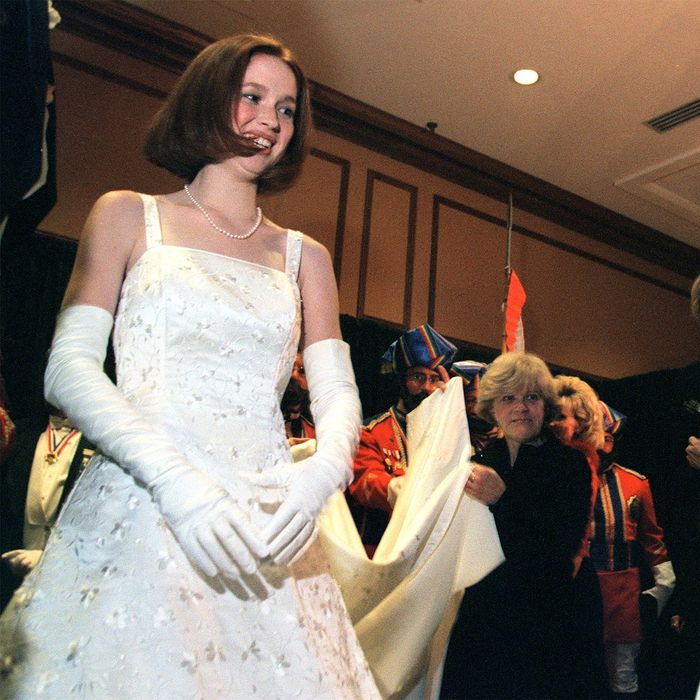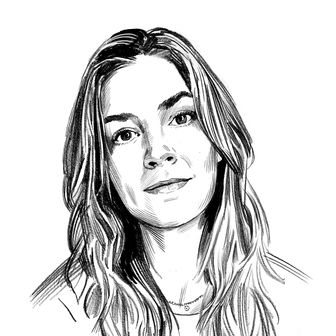
When the Veiled Prophet Ball became a nationally known quantity on Monday, the prevailing reaction was the reasonable one: shock and confusion. The images bouncing around online this week range from jarring to inexplicable: Here is a man draped in white robes, hiding his face behind little lace curtains; here is … sorry, is that Kimmy Schmidt in the ball gown and the opera gloves? Who are those children smiling adoringly up at her, what do they want? Having grown up in St. Louis and attended the ball as a guest, I can tell you that the kids in the feathery caps are her “pages,” and the turbaned white man standing just behind her bridal train is a “Bengal Lancer,” and the over-the-elbow gloves are obligatory, at least until dinner is served. Learning that a teenage Ellie Kemper made her debut at the ball in 1999, I didn’t feel surprised. My first thought went something like, Well, of course.
I attended the same small private high school Kemper did, and within that tiny world, the ball, or “VP” as we referred to it, was an eminently common thing. At least for students from the city’s oldest and wealthiest families, VP remains a regular holiday tradition, if not an uncontroversial one: As the internet has discovered, two Confederates founded the organization, inducted white St. Louis elites, and refused to accept Black and Jewish members for the next century. Its mascot looks like a Grand Wizard. The optics alone are atrocious.
As the photos of Kemper circulated, some called on her to publicly “unclaim” her title; others devised names like “KKK Princess,” although, as has been repeated in various explainers on Veiled Prophet this week, the organization shares no known ties to the Klan. Still others have defended her, arguing that all of this happened more than two decades ago, when the woman in question was 19 years old, and how unfair, how pointless, to dredge it back up now. This camp wondered (and here I am looking at comments on the Cut’s own Instagram) “if this is meant to prompt a dialogue about debutante balls and classism, or shame Ellie Kemper for a choice she made as a teenager?”
Classism is a crucial component of this story, but I also wonder about shame. I wonder if that is something Kemper feels, in hindsight, not because I believe her to be racist for walking in a deb ball, but because I believe racism buoyed the systems of white privilege in which we grew up. When I think about my own attendance at VP, shame is the emotion that swells to the surface. I remember how the prophet’s first appearance took me aback, how overt the resemblance was, how little it seemed to faze the crowd around me. Shame drove me to type “veiled prophet KKK?” into my Google search bar a few days later, shame drove me to untag the photos. I felt shame again this week, as people all across the country looked at a man in a white veil and saw the same thing I did over a decade ago. Often, things are exactly what they seem.
In its original form, Veiled Prophet loomed as a sharp rejoinder to the city’s laborers, a secret society of the wealthiest St. Louis leaders founded in the wake of the Great Railroad Strike. That event saw Black and white workers unite to bring freight to a standstill — successful cooperation the upper class read as an assault on the social hierarchy. In 1878, the “city fathers” held their first parade, a propagandistic celebration lionizing wealth and introducing the prophet. A 1928 VP publication describes him as a “beloved despot” who “rules with an iron hand encased in velvet”; an 1878 flyer for the parade shows him wearing a peaked white hood and long white robes, clutching two shotguns and a pistol. Although some historians have argued that the KKK did not adopt that uniform until 1915, the parallel is unmistakable.
Earlier this week, the VPO issued a statement saying it “is dedicated to civic progress, economic contributions and charitable causes in St. Louis,” that it “believes in and promotes inclusion, diversity and equality for this region,” and that it “absolutely reject[s] racism.” These days, the organization does have members of color, along with Jewish members, and it does do philanthropy. But while no explicit links between VP and the KKK have ever been confirmed, racism doesn’t always arrive wrapped in white robes. One need only look at St. Louis history — as the northernmost port in the U.S. slave trade, in a Union state nonetheless represented by a star on the Confederate flag, where officials have long exploited municipal systems to push Black residents out of their homes and entrench cyclical poverty, and where segregation persists today — to understand how those at the top have leveraged race to confer and withhold status. From its inception, the VPO has consolidated power in the same hands that have always had it. Overwhelmingly, those hands have been white.
According to a St. Louis trope I have heard repeated since forever, the first thing two strangers often ask each other upon learning they both grew up there is: “Where’d you go to high school?” Realistically, this is probably a question only rich people ask each other, and when I hear it now, it reads as a subtle inquest into a new acquaintance’s place in the socioeconomic order. In the city itself, decades of red-lining and white flight have ravaged the public school system, leaving mostly Black districts wildly underfunded and understaffed. Meanwhile, a reported 38 percent of white children in St. Louis attended those public schools as of January 2021; the majority probably enrolled at one of the many private and parochial schools in the area, like I did. Despite living in the city, I went to secondary school out in the suburbs; one of the more prestigious private options, and ostensibly the most progressive, at least in terms of its curriculum and its politics. When I started as a seventh-grader in 2002, the student body was not particularly diverse, neither in terms of race, nor ethnicity, nor household income. While there were plenty of kids there whose families were not wealthy, we are still talking about the kind of school that required white gowns or tuxes at graduation.
I say this not by way of complaint — I don’t resent the education I received, far from it. Still, undercurrents of white supremacy ran through so many of the institutions in my orbit. Consider the whites-only country clubs that openly eschewed Black membership into the ‘90s (and in some cases, the aughts) two of which bordered my high school; or the men’s only social clubs that, at the same time, were just beginning to allow the occasional woman onto the premises. When I was a teenager, it felt easy enough to shrug off VP as just another strain of “legacy shit,” as a high-school friend recently put it to me.
Even though nothing about it — not the pseudo-mysticism, not the sparkly jesters, and certainly not the prophet himself — looks, or is, normal, it was nonetheless common. It was so common that, as a 19-year-old, I didn’t totally get why my mother, who is not from St. Louis, became a rage furnace when I told her I was thinking about going. I understood better once I saw the spectacle for myself: the grown men parading by in uniforms reminiscent of the British Indian Army, the feathered headdresses, the polyester Afros. And that’s before you get to the big man in the doily — no amount of Mardi Gras frill can obscure the connotations of that costuming choice. And still I went back the next year, with a friend who did not want to walk, did not agree with the larger deb-ball premise, and yet felt the family pressure. I’m pretty sure my mother briefly stopped speaking to me after I told her, and while I now got where her anger came from, I also thought she was overreacting. The friend would fulfill her family obligation, then we would party, and none of it had to mean anything more than that. So many of my schoolmates, most but not all of them white, would be there, and I don’t think the offensive elements were lost on any of them. Another what-the-fuck moment for the pile.
Talking about the ball with other friends who have attended, both white and not, the conversation keeps circling back on one point: This kind of thing happened all the time. For me, I think that’s why the appearance of the prophet surprised more than it shocked. Repetition is one way you come to recognize something without really seeing it for what it is, and privilege — being accustomed to a lack of consequences — can sustain bad behavior for a long time. That might help explain how a whole room full of adults can look at the display, year after year after year, and not clock what so much of the country is reacting to right now.
And I wonder if apathy is what happens when you have watched this pageant unfold for as long as you can remember, just like your parents did, just like your grandparents did. I wonder at what point white supremacy becomes so deeply normalized that you simply cease to see it. Maybe the adults in that ballroom thought it was harmless fun, or maybe they knew exactly what it all stood for. I do not know what’s worse, not to see it or not to care.
Which is why I hope Kemper will address it. Walking in a bizzaro deb ball may have felt like some dumb thing her parents wanted her to do, but hey, there’d be a big flashy gala afterward. It is also possible that she looked forward to the moment for years. I have no idea what she thought about the whole thing, as she has so far remained silent on the matter. What interests me most is how she feels about it now. Yes, the resurfaced photo came totally out of the blue and yes, we’re talking about a pageant from 20 years ago. Yet 2021’s installment of VP will likely unfold exactly the same way. Without blunt acknowledgment from the people inside institutions like this, there’s no chance of change.
Update: On Monday, June 7, Kemper apologized for her participation in the ball in a statement posted to Instagram. “The century-old organization that hosted the debutante ball had an unquestionably racist, sexist, and elitist past. I was not aware of this history at the time, but ignorance is no excuse,” she wrote. “Because of my race and my privilege, I am the beneficiary of a system that has dispensed unequal justice and unequal rewards.” Read her full statement here.





